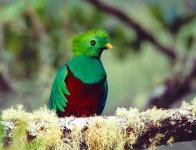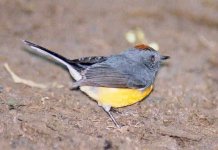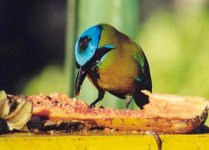Wildflower
Active member
This was our second trip to Costa Rica. We stayed in four different places and had five guides. Three of them were exceptional.
Two years ago we did not keep list and only when we took a guided trip in Monteverde Park we were able to list 17 species. So this January we added 298 species. We now have total 315 species.
Below is our complete list and our own photo of Resplendent Quetzal :
Highland Tinamou
Least Grebe
Brown Pelican
Neotropic Cormorant
Magnificent Frigatebird
Great Blue Heron
Great Egret
Little Blue Heron
Snowy Egret
Cattle Egret
Green Heron
Black-crowned Night-Heron
Boat-billed Heron
Bare-throated Tiger-Heron
Wood Stork
White Ibis
Black-bellied Whistling-Duck
Black Vulture
Turkey Vulture
King Vulture
Osprey
Hook-billed Kite
Swallow-tailed Kite
White-tailed Kite
Snail Kite
Double-toothed Kite
Tiny Hawk
Crane Hawk
White Hawk
Common Black-Hawk
Mangrove Black-Hawk
Gray Hawk
Roadside Hawk
Short-tailed Hawk
Zone-tailed Hawk
Crested Caracara
Yellow-headed Caracara
Laughing Falcon
Bat Falcon Falco
Plain Chachalaca
Black Guan
Spotted Wood-Quail
White-throated Crake
Gray-breasted Crake
Purple Gallinule
Northern Jacana
Greater Yellowlegs
Willet
Rock Dove
Band-tailed Pigeon
Pale-vented Pigeon
Red-billed Pigeon
Short-billed Pigeon
Ruddy Pigeon
Mourning Dove
White-winged Dove
Common Ground-Dove
Ruddy Ground-Dove
Blue Ground-Dove
White-tipped Dove
Gray-chested Dove
Scarlet Macaw
Crimson-fronted Parakeet
Sulphur-winged Parakeet
Orange-chinned Parakeet
Brown-hooded Parrot
White-crowned Parrot
White-fronted Parrot
Red-lored Parrot
Yellow-crowned Parrot
Mealy Parrot
Mangrove Cuckoo
Squirrel Cuckoo
Smooth-billed Ani
Striped Cuckoo
Black Swift
White-chinned Swift
White-collared Swift
Lesser Swallow-tailed Swift
White-tipped Sicklebill
Bronzy Hermit
Green Hermit
Little Hermit
Western Long-tailed Hermit
Green-fronted Lancebill
Scaly-breasted Hummingbird
Violet Sabrewing
White-necked Jacobin Brown Violet-ear
Green Violet-ear
Violet-headed Hummingbird
White-crested Coquette
Fiery-throated Hummingbird
White-tailed Emerald
Coppery-headed Emerald
Black-bellied Hummingbird
Rufous-tailed Hummingbird
Cinnamon Hummingbird
White-bellied Emerald
Charming Hummingbird
White-bellied Mountain-gem
White-throated Mountain-gem
Purple-throated Mountain-gem
Green-crowned Brilliant
Magnificent Hummingbird
Purple-crowned Fairy
Long-billed Starthroat
Scintillant Hummingbird
Volcano Hummingbird
Black-headed Trogon
Baird's Trogon
Violaceous Trogon
Collared Trogon
Orange-bellied Trogon
Black-throated Trogon
Slaty-tailed Trogon
Resplendent Quetzal
Belted Kingfisher
Ringed Kingfisher
Amazon Kingfisher
Green Kingfisher
Blue-crowned Motmot
Keel-billed Motmot
Rufous-tailed Jacamar
White-necked Puffbird
White-whiskered Puffbird
Red-headed Barbet
Fiery-billed Aracari
Keel-billed Toucan
Chesnut-mandibled Toucan
Emerald Toucanet
Acorn Woodpecker
Golden-naped Woodpecker
Red-crowned Woodpecker
Hairy Woodpecker
Golden-olive Woodpecker
Lineated Woodpecker
Ruddy Treerunner
Plain Xenops
Streak-breasted Treehunter
Ruddy Foliage-gleaner
Tawny-winged Woodcreeper
Wedge-billed Woodcreeper
Buff-throated Woodcreeper
Cocoa Woodcreeper
Black-striped Woodcreeper
Spot-crowned Woodcreeper
Great Antshrike
Black-hooded
Dotted-winged Antwren
Chestnut-backed Antbird
Rufous Piha
Lovely Cotinga
Turquoise Cotinga
Yellow-billed Cotinga
Orange-collared Manakin
Blue-crowned Manakin
Red-capped Manakin
Yellow-crowned Tyrannulet
Greenish Elaenia
Yellow-bellied Elaenia
Lesser Elaenia
Mountain Elaenia
Torrent Tyrannulet
Olive-striped Flycatcher
Paltry Tyrannulet
Common Tody-Flycatcher
Yellow-olive Flycatcher
Black-tailed Flycatcher
Tufted Flycatcher
Olive-sided Flycatcher
Dark Pewee
Tropical Pewee
Yellow-bellied Flycatcher
Alder Flycatcher
White-throated Flycatcher
Yellowish Flycatcher
Black-capped Flycatcher
Black Phoebe
Dusky-capped Flycatcher
Nutting's Flycatcher
Great Crested Flycatcher
Great Kiskadee
Boat-billed Flycatcher
Social Flycatcher
Gray-capped Flycatcher
Golden-bellied
Streaked Flycatcher
Sulphur-bellied Flycatcher
Piratic Flycatcher
Tropical Kingbird
Scissor-tailed Flycatcher
White-winged Becard
Black-and-white Becard
Rose-throated Becard
Masked Tityra
Black-crowned Tityra
Gray-breasted Martin
Mangrove Swallow
Blue-and-white Swallow
Long-tailed Silky-flycatcher
Riverside Wren
Plain Wren
House Wren
Ochraceous Wren
Gray-breasted Wood-Wren
Nightingale Wren
Gray Catbird
Black-faced Solitaire
Black-billed Nightingale-Thrush
Mountain Robin
Clay-colored Robin
Tropical Gnatcatcher
Brown Jay
Mangrove Vireo
Yellow-throated Vireo
Philadelphia Vireo
Red-eyed Vireo
Scrub Greenlet
Green Shrike-Vireo
Rufous-browed Peppershrike
Tennessee Warbler
Flame-throated Warbler
Yellow Warbler
Chestnut-sided Warbler
Black-throated Green Warbler
Townsend's Warbler
Yellow-throated Warbler
Palm Warbler
Black-and-white Warbler
American Redstart
Mourning Warbler
Common Yellowthroat
Gray-crowned Yellowthroat
Wilson's Warbler
Slate-throated Redstart
Collared Redstart
Black-cheeked Warbler
Wrenthrush
Bananaquit Coereba flaveola
Common Bush-Tanager
Sooty-capped Bush-Tanager
Olive Tanager
Gray-headed Tanager
White-throated Shrike-Tanager
White-shouldered Tanager
Red-crowned Ant-Tanager
Black-cheeked Ant-Tanager
Scarlet Tanager
Summer Tanager
Flame-colored
White-winged Tanager
Cherrie's Tanager
Blue-gray Tanager
Palm Tanager
Blue-and-gold Tanager
Scrub Euphonia Yellow-crowned Euphonia
Elegant Euphonia (Blue-hooded Euphonia)
Spotted-crowned Euphonia
Tawny-capped Euphonia
Silver-throated Tanager
Speckled Tanager
Bay-headed Tanager
Golden-hooded Tanager
Scarlet-thighed Dacnis
Blue Dacnis
Green Honeycreeper
Shining Honeycreeper
Red-legged Honeycreeper
Blue-black Grassquit
Slate-colored Seedeater
Variable Seedeater
White-collared Seedeater
Yellow-faced Grassquit
Slaty Finch
Slaty Flowerpiercer
Yellow-thighed Finch
Stripe-headed Brush-Finch
Orange-billed
Olive Sparrow
Black-striped Sparrow
White-eared Ground-Sparrow
Stripe-headed Sparrow
Rusty Sparrow
Grasshopper Sparrow
Rufous-collared Sparrow
Volcano Junco
Buff-throated Saltator
Black-headed Saltator
Black-thighed Grosbeak
Rose-breasted Grosbeak
Blue-black Grosbeak
Blue Grosbeak
Red-breasted Blackbird
Great-tailed Grackle
Bronzed Cowbird
Giant Cowbird
Baltimore Oriole
Yellow-billed Cacique
Scarlet-rumped Cacique
Yellow-bellied Siskin
Lesser Goldfinch
Two years ago we did not keep list and only when we took a guided trip in Monteverde Park we were able to list 17 species. So this January we added 298 species. We now have total 315 species.
Below is our complete list and our own photo of Resplendent Quetzal :
Highland Tinamou
Least Grebe
Brown Pelican
Neotropic Cormorant
Magnificent Frigatebird
Great Blue Heron
Great Egret
Little Blue Heron
Snowy Egret
Cattle Egret
Green Heron
Black-crowned Night-Heron
Boat-billed Heron
Bare-throated Tiger-Heron
Wood Stork
White Ibis
Black-bellied Whistling-Duck
Black Vulture
Turkey Vulture
King Vulture
Osprey
Hook-billed Kite
Swallow-tailed Kite
White-tailed Kite
Snail Kite
Double-toothed Kite
Tiny Hawk
Crane Hawk
White Hawk
Common Black-Hawk
Mangrove Black-Hawk
Gray Hawk
Roadside Hawk
Short-tailed Hawk
Zone-tailed Hawk
Crested Caracara
Yellow-headed Caracara
Laughing Falcon
Bat Falcon Falco
Plain Chachalaca
Black Guan
Spotted Wood-Quail
White-throated Crake
Gray-breasted Crake
Purple Gallinule
Northern Jacana
Greater Yellowlegs
Willet
Rock Dove
Band-tailed Pigeon
Pale-vented Pigeon
Red-billed Pigeon
Short-billed Pigeon
Ruddy Pigeon
Mourning Dove
White-winged Dove
Common Ground-Dove
Ruddy Ground-Dove
Blue Ground-Dove
White-tipped Dove
Gray-chested Dove
Scarlet Macaw
Crimson-fronted Parakeet
Sulphur-winged Parakeet
Orange-chinned Parakeet
Brown-hooded Parrot
White-crowned Parrot
White-fronted Parrot
Red-lored Parrot
Yellow-crowned Parrot
Mealy Parrot
Mangrove Cuckoo
Squirrel Cuckoo
Smooth-billed Ani
Striped Cuckoo
Black Swift
White-chinned Swift
White-collared Swift
Lesser Swallow-tailed Swift
White-tipped Sicklebill
Bronzy Hermit
Green Hermit
Little Hermit
Western Long-tailed Hermit
Green-fronted Lancebill
Scaly-breasted Hummingbird
Violet Sabrewing
White-necked Jacobin Brown Violet-ear
Green Violet-ear
Violet-headed Hummingbird
White-crested Coquette
Fiery-throated Hummingbird
White-tailed Emerald
Coppery-headed Emerald
Black-bellied Hummingbird
Rufous-tailed Hummingbird
Cinnamon Hummingbird
White-bellied Emerald
Charming Hummingbird
White-bellied Mountain-gem
White-throated Mountain-gem
Purple-throated Mountain-gem
Green-crowned Brilliant
Magnificent Hummingbird
Purple-crowned Fairy
Long-billed Starthroat
Scintillant Hummingbird
Volcano Hummingbird
Black-headed Trogon
Baird's Trogon
Violaceous Trogon
Collared Trogon
Orange-bellied Trogon
Black-throated Trogon
Slaty-tailed Trogon
Resplendent Quetzal
Belted Kingfisher
Ringed Kingfisher
Amazon Kingfisher
Green Kingfisher
Blue-crowned Motmot
Keel-billed Motmot
Rufous-tailed Jacamar
White-necked Puffbird
White-whiskered Puffbird
Red-headed Barbet
Fiery-billed Aracari
Keel-billed Toucan
Chesnut-mandibled Toucan
Emerald Toucanet
Acorn Woodpecker
Golden-naped Woodpecker
Red-crowned Woodpecker
Hairy Woodpecker
Golden-olive Woodpecker
Lineated Woodpecker
Ruddy Treerunner
Plain Xenops
Streak-breasted Treehunter
Ruddy Foliage-gleaner
Tawny-winged Woodcreeper
Wedge-billed Woodcreeper
Buff-throated Woodcreeper
Cocoa Woodcreeper
Black-striped Woodcreeper
Spot-crowned Woodcreeper
Great Antshrike
Black-hooded
Dotted-winged Antwren
Chestnut-backed Antbird
Rufous Piha
Lovely Cotinga
Turquoise Cotinga
Yellow-billed Cotinga
Orange-collared Manakin
Blue-crowned Manakin
Red-capped Manakin
Yellow-crowned Tyrannulet
Greenish Elaenia
Yellow-bellied Elaenia
Lesser Elaenia
Mountain Elaenia
Torrent Tyrannulet
Olive-striped Flycatcher
Paltry Tyrannulet
Common Tody-Flycatcher
Yellow-olive Flycatcher
Black-tailed Flycatcher
Tufted Flycatcher
Olive-sided Flycatcher
Dark Pewee
Tropical Pewee
Yellow-bellied Flycatcher
Alder Flycatcher
White-throated Flycatcher
Yellowish Flycatcher
Black-capped Flycatcher
Black Phoebe
Dusky-capped Flycatcher
Nutting's Flycatcher
Great Crested Flycatcher
Great Kiskadee
Boat-billed Flycatcher
Social Flycatcher
Gray-capped Flycatcher
Golden-bellied
Streaked Flycatcher
Sulphur-bellied Flycatcher
Piratic Flycatcher
Tropical Kingbird
Scissor-tailed Flycatcher
White-winged Becard
Black-and-white Becard
Rose-throated Becard
Masked Tityra
Black-crowned Tityra
Gray-breasted Martin
Mangrove Swallow
Blue-and-white Swallow
Long-tailed Silky-flycatcher
Riverside Wren
Plain Wren
House Wren
Ochraceous Wren
Gray-breasted Wood-Wren
Nightingale Wren
Gray Catbird
Black-faced Solitaire
Black-billed Nightingale-Thrush
Mountain Robin
Clay-colored Robin
Tropical Gnatcatcher
Brown Jay
Mangrove Vireo
Yellow-throated Vireo
Philadelphia Vireo
Red-eyed Vireo
Scrub Greenlet
Green Shrike-Vireo
Rufous-browed Peppershrike
Tennessee Warbler
Flame-throated Warbler
Yellow Warbler
Chestnut-sided Warbler
Black-throated Green Warbler
Townsend's Warbler
Yellow-throated Warbler
Palm Warbler
Black-and-white Warbler
American Redstart
Mourning Warbler
Common Yellowthroat
Gray-crowned Yellowthroat
Wilson's Warbler
Slate-throated Redstart
Collared Redstart
Black-cheeked Warbler
Wrenthrush
Bananaquit Coereba flaveola
Common Bush-Tanager
Sooty-capped Bush-Tanager
Olive Tanager
Gray-headed Tanager
White-throated Shrike-Tanager
White-shouldered Tanager
Red-crowned Ant-Tanager
Black-cheeked Ant-Tanager
Scarlet Tanager
Summer Tanager
Flame-colored
White-winged Tanager
Cherrie's Tanager
Blue-gray Tanager
Palm Tanager
Blue-and-gold Tanager
Scrub Euphonia Yellow-crowned Euphonia
Elegant Euphonia (Blue-hooded Euphonia)
Spotted-crowned Euphonia
Tawny-capped Euphonia
Silver-throated Tanager
Speckled Tanager
Bay-headed Tanager
Golden-hooded Tanager
Scarlet-thighed Dacnis
Blue Dacnis
Green Honeycreeper
Shining Honeycreeper
Red-legged Honeycreeper
Blue-black Grassquit
Slate-colored Seedeater
Variable Seedeater
White-collared Seedeater
Yellow-faced Grassquit
Slaty Finch
Slaty Flowerpiercer
Yellow-thighed Finch
Stripe-headed Brush-Finch
Orange-billed
Olive Sparrow
Black-striped Sparrow
White-eared Ground-Sparrow
Stripe-headed Sparrow
Rusty Sparrow
Grasshopper Sparrow
Rufous-collared Sparrow
Volcano Junco
Buff-throated Saltator
Black-headed Saltator
Black-thighed Grosbeak
Rose-breasted Grosbeak
Blue-black Grosbeak
Blue Grosbeak
Red-breasted Blackbird
Great-tailed Grackle
Bronzed Cowbird
Giant Cowbird
Baltimore Oriole
Yellow-billed Cacique
Scarlet-rumped Cacique
Yellow-bellied Siskin
Lesser Goldfinch
Attachments
Last edited:







